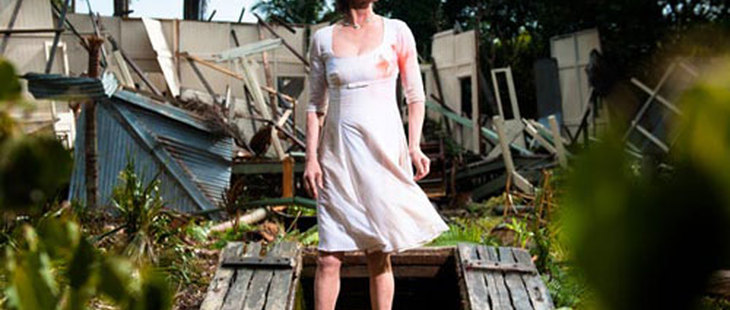
Is there a more underrated director than Fred Schepisi? Though a major figure in his homeland, Australia, he’s never really gotten his due among film snobs. The movies he made during the ’80s — Barbarosa, Iceman, Plenty, A Cry in the Dark, Roxanne, and The Russia House — earned him a reputation as a solid craftsman, but they didn’t bring auteur status, and most of his subsequent output has been ignored. (He’s also never been nominated for an Oscar, for whatever that’s worth.) And yet Schepisi is a master filmmaker when he has the material. One of the few directors possessed of a literary bent as well as a true cinematic sense, he’s made at least five great films over the course of his four decades in the business, which isn’t something that can be said of many of his more celebrated peers.
The great works began in the 1970s with the one-two punch of The Devil’s Playground, a semi-autobiographical work about his Catholic school upbringing, and The Chant of Jimmie Blacksmith, an adaptation of Thomas Kenneally’s classic novel of a half-breed aborigine caught between two cultures. (The latter film is still considered by many to be the great Australian film.) In 1993, he did a peerless job of filming John Guare’s play Six Degrees of Separation (and, in the process, gave Will Smith his first — and still best — screen role). In 2002, he made what may be the most underrated film of the decade, Last Orders, a remarkably soulful adaptation of Graham Swift’s novel about the waning days of Britain’s “greatest generation,” starring Michael Caine, Bob Hoskins, Helen Mirren, and several other legends. The former Salon film critic Charles Taylor was one of the few to recognize its qualities at the time, describing it as an “unassuming masterpiece” and “funny in a way that makes you ache with sadness (the way Chekhov is funny), profound without ever being self-important, and warm without ever succumbing to sentimentality.”
That description could apply equally to Schepisi’s latest, The Eye of the Storm, an adaptation of Nobel Prize-winning Australian author Patrick White’s 1973 novel. An intimate epic, the film is about two adult siblings (Judy Davis and Geoffrey Rush) who return home to the old-money Sydney suburb of Centennial Park to visit their dying, flinty mother (Charlotte Rampling). Gradually, it expands to become a snapshot of the entire country circa the early ’70s. It’s hard to imagine less fashionable subject matter, and Schepisi is such a low-key, unobtrusive artist that I fear his movie is going to get lost amid all the higher-profile holiday releases. (It hasn’t even been picked up for distribution in the U.S. yet, which is why you’ve heard so little about it.) But it’s one of the two or three best films made this year, the sort of densely plotted, sumptuously photographed, beautifully layered work that used to find favour with adult audiences but which is now nearly extinct. Not only that, it’s a brilliant actors’ showcase, from each of the three leads right down to the smallest bit players. The print ads make it look like some sort of sleepy Merchant-Ivory throwback, but it’s not staid in the least. It’s too good-humoured, too vital.
The film begins with a brief flashback to the storm of the title, in which a still healthy-looking Elizabeth Hunter (Rampling) stands on a storm-tossed beach in a white dress, looking dazed and with a smear of blood on her forehead. Then we’re thrust headlong into the present-tense via a deft series of cross-cuts (one of Schepisi’s stylistic specialties): Elizabeth, now much older and bedridden after a stroke, is being made up by her servants, while her children — the Princess de Lascabanes (Davis) and the second-rate actor Basil Hunter (Rush) — arrive at their respective hotels. The princess, whose real name is Dorothy (she married into royalty, then divorced), has reluctantly returned from Paris, whereas Basil has reluctantly returned from London, and before either can face Australia and their mother again they must, like her, erect their false fronts: an age-concealing daub of rouge here, a bit of mascara there (that’s Basil), a brooch placed just-so over a hole in a cashmere sweater. The cross-cutting also lets us contrast how all three treat their subordinates: while Elizabeth is alternately affectionate and tyrannical with her servants, Basil is fake-chummy with hotel staff, Dorothy distracted and tight-fisted. In a lesser film, all of this detail might seem a bit too on-the-nose, but here it’s merely our departure point. We may think we’ve got these comically affected snobs pegged, but there’s much more to them than we first glimpse. (Compare this to the recent Shame, in which we learn everything we’ll ever know about the characters the minute they’re introduced.)
Once Dorothy and Basil convene at their mother’s estate, the true purpose of their visit becomes clear: they’re worried about their inheritance. When Elizabeth guesses as much, Dorothy protests. “Can’t you make any allowance for simple human affection?” she wails. But it’s clear she and Basil aren’t there out of affection for their casually cruel mother, who withholds love and never fails to express her disappointment with them. When Basil, the more favoured of the two, gently admonishes his mother for never having seen any of his performances, she explains it was because it would break her heart if he weren’t any good. And besides, she adds, she read the reviews of his Lear.
That reference to King Lear is no accident, of course — if you know the play, you’ll recognize the parallels. (Part of the joke is that Basil doesn’t remotely have the sensibility or stature to play the role.) But to my mind the film has more in common with cinema’s classic class-conscious pictures: Renoir’s The Rules of the Game, Bergman’s Smiles of a Summer Night, and Robert Altman’s Gosford Park. Like those films, The Eye of the Storm starts small, as if to focus on a narrow slice of society. But over the course of the picture we add a growing array of perspectives, including Elizabeth’s pretty, lower-class nurse Flora (the director’s daughter, Alexandra Schepisi, in a marvellous performance), who briefly takes up with Basil; Jewish-German housekeeper Lotte (Helen Morse), still haunted by the Holocaust; Elizabeth’s upper-middle-class executor Arnold (John Gaden); Arnold’s wife Lal (Robyn Nevin), possessed of a deep mistrust of Elizabeth; and the outback McCrory family, caretakers of the Hunters’ country estate. Together, the cast embodies (and illuminates) the country’s changing social mores, and yet no one stands as a mere cultural signpost. We’re made to feel each has a life of his or her own, and that we could follow any one of them into their own private dramas.
But the Hunter family compels our attention most, partly because it’s they who most embody the frustrated, aspirational qualities of the country itself. Like Canada, Australia in the ’70s was a nation coming into its own, and with growth comes the corresponding need for outside validation. Basil and Dorothy have spent their adult lives chasing it in Europe (not having got much validation at home), yet neither has much to show for it. Basil’s stage career consists mostly of tired, mouldering farces, while Dorothy is a tolerated poseur in Parisian high society, her ex-husband’s family having black-balled her. For the first half of the film, much of the comedy stems from Dorothy and Basil’s self-defeating attitudes toward Australian culture (Dorothy sniffs at a platypus blanket, Basil cheerily condescends to a kangaroo pie). But the film finds its soul in its second half, as at least one of the two siblings — Dorothy — begins to reckon with those attitudes and her own personal failings. The arc of the film bends in two directions: forward, as Dorothy and Basil attempt (with less and less confidence) to assert control over the family finances; and backward, as Schepisi gradually fills us in on the family’s past and the circumstances that led Elizabeth to be standing bloodied and unbowed on that beach.
We haven’t seen Davis onscreen for awhile now (her last notable appearance was a small one, in Sofia Coppola’s Marie Antoinette), but here she reminds us all over again what we’ve been missing. As Dorothy, she gives a major performance — beautifully modulated and deeply empathetic. In the hands of a lesser actress, Dorothy might come across merely as a pathetic upper-class twit, but from the start Davis lets us see the sadness and regret underneath the character’s pretensions. Her Dorothy yearns to be other than what she is, and it’s enormously touching seeing her grope toward some measure of peace with herself and her mother. Davis’s final scene with Rampling is so lovely in its unaffected plainness that it puts the usual tacked-on movie epiphanies to shame; it’s like a gift to the audience.
As for Rush — a great actor who occasionally descends into hamminess — he gives Basil just the right combination of pomposity and earnestness. At bottom, Basil is still a scared, silly little boy searching desperately for approval, and his tragedy is that he’s too insubstantial to even be tragic. But Schepisi is too generous a director to leave him completely out in the cold. Towards the end, there’s a brief, elegant intimation that Basil may yet find stature — even grace — in his own small way.
The film’s dominating figure, of course, is Elizabeth, and Rampling is magnificent in the role. Instead of playing the typical gorgon-matriarch (the sort of shallow, comic caricature that inevitably wins awards), she balances the character’s monstrous self-absorption with an almost disturbing capacity for sensual pleasure. As horrible as she’s been to her children, there’s a reason she’s the last woman standing in the eye of that storm, and the implications of her “victory” — if that’s what it is — remain unresolved as the credits roll.
The hype for the silent-film homage The Artist has been building ever since it debuted at Cannes last May, and though I always try to take buzz with a grain of salt, I was still underwhelmed when I finally saw the movie. It’s a perfectly nice, inoffensive picture, and even quite charming at times, but the idea that it’s something great — even just light-as-air great, as so many reviewers keep saying — is kind of bogus. In fact, it begs the question: how can a movie be said to be great (or even just substantial) when it contains so little that’s new, when it’s a deliberate facsimile? By slavishly imitating the look and feel of a silent film — as opposed to simply adopting the techniques and fashioning something fresh from them — The Artist limits itself to the status of pastiche. And to director Michel Hazanavicius’s credit, he’s never once claimed otherwise. In interviews, he says he set out to make a fun, minor homage, and that’s exactly what he’s done. If I’m protesting too much, it’s because I can’t bear seeing a highly lauded novelty like The Artist declared the year’s best picture when truly outstanding films — films like The Eye of the Storm — get cast aside. There’s nothing wrong with novelty, but when it’s elevated to the status of art, true art suffers.
Scott MacDonald is Toronto Standard’s film critic.














